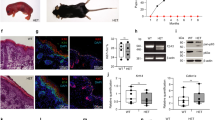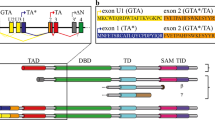Abstract
The p53 family of proteins consists of p53, p63 and p73, which are transcription factors that affect both cancer and development. It is now emerging that these proteins also regulate maternal reproduction. Whereas p63 is important for maturation of the egg, p73 ensures normal mitosis in the developing blastocyst. p53 subsequently regulates implantation of the embryo through transcriptional control of leukaemia inhibitory factor. Elucidating the cell biological basis of how these factors regulate female fertility may lead to new approaches to the control of human maternal reproduction.
This is a preview of subscription content, access via your institution
Access options
Subscribe to this journal
Receive 12 print issues and online access
$189.00 per year
only $15.75 per issue
Buy this article
- Purchase on Springer Link
- Instant access to full article PDF
Prices may be subject to local taxes which are calculated during checkout




Similar content being viewed by others
References
Wade, M., Wang, Y. V. & Wahl, G. M. The p53 orchestra: Mdm2 and Mdmx set the tone. Trends Cell Biol. 20, 299–309 (2010).
Feng, Z. & Levine, A. J. The regulation of energy metabolism and the IGF-1/mTOR pathways by the p53 protein. Trends Cell Biol. 20, 427–434 (2010).
Melino, G. Journal club. A cancer biologist weighs up p53, metabolism and cancer. Nature 466, 905 (2010).
Dötsch, V., Bernassola, F., Coutandin, D., Candi, E. & Melino, G. p63 and p73, the ancestors of p53. Cold Spring Harb. Perspect. Biol. 2, a004887 (2010).
Vousden, K. H. & Lane, D. P. p53 in health and disease. Nature Rev. Mol. Cell Biol. 8, 275–283 (2007).
Riley, T., Sontag, E., Chen, P. & Levine, A. Transciptional control of human p53-regulated genes. Nature Rev. Mol. Cell Biol. 9, 402–412 (2008).
Flores, E. R. et al. p63 and p73 are required for p53-dependent apoptosis in response to DNA damage. Nature 416, 560–564 (2002).
Tomasini, R. et al. TAp73 knockout shows genomic instability with infertility and tumor suppressor functions. Genes Dev. 22, 2677–2691 (2008).
Wilhelm, M. T. et al. Isoform-specific p73 knockout mice reveal a novel role for ΔNp73 in the DNA damage response pathway. Genes Dev. 24, 549–560 (2010).
Yang, A., Kaghad, M., Caput, D. & McKeon, F. On the shoulders of giants: p63, p73 and the rise of p53. Trends Genet. 18, 90–95 (2002).
Scoumanne, A., Harms, K. L. & Chen, X. Structural basis for gene activation by p53 family members. Cancer Biol. Ther. 4, 1178–1185 (2005).
Stehmeier, P. & Muller, S. Regulation of p53 family members by the ubiquitin-like SUMO system. DNA Repair (Amst.) 8, 491–498 (2009).
Tomasini, R., Mak, T. W. & Melino, G. The impact of p53 and p73 on aneuploidy and cancer. Trends Cell Biol. 18, 244–252 (2008).
Senoo, M., Pinto, F., Crum, C. P. & McKeon, F. p63 is essential for the proliferative potential of stem cells in stratified epithelia. Cell 129, 523–536 (2007).
Candi, E. et al. DNp63 regulates thymic development through enhanced expression of FgfR2 and Jag2. Proc. Natl Acad. Sci. USA. 104, 11999–12004 (2007).
Finlan, L. E. & Hupp, T. R. p63: the phantom of the tumor suppressor. Cell Cycle 6, 1062–1071 (2007).
Liu, Y. et al. p53 regulates hematopoietic stem cell quiescence. Cell Stem Cell 4, 37–48 (2009).
Komarova, E. A. et al. p53 is a suppressor of inflammatory response in mice. FASEB J. 19, 1030–1032 (2005).
Cano, C. E. et al. Tumor protein 53-induced nuclear protein 1 is a major mediator of p53 antioxidant function. Cancer Res. 69, 219–226 (2009).
Scrable, H., Medrano, S. & Ungewitter, E. Running on empty: how p53 controls INS/IGF signaling and affects life span. Exp. Gerontol. 44, 93–100 (2009).
Belyi, V. et al. The origins and evolution of the p53 family of genes. Cold Spring Harb. Perspect. Biol. 2, a001198 (2010).
Belyi, V. & Levine, A. J. One billion years of p53/p63/p73 evolution. Proc. Natl Acad. Sci. USA. 106, 17609–17610 (2009).
Donehower, L. A. et al. Mice deficient for p53 are developmentally normal but susceptible to spontaneous tumours. Nature 356, 215–221 (1992).
Mills, A. A. et al. p63 is a p53 homologue required for limb and epidermal morphogenesis. Nature 398, 708–713 (1999).
Yang, A. et al. p73-deficient mice have neurological, pheromonal and inflammatory defects but lack spontaneous tumours. Nature 404, 99–103 (2000).
Su, X. et al. TAp63 prevents premature aging by promoting adult stem cell maintenance. Cell Stem Cell 5, 64–75 (2009).
Suh, E. K. et al. p63 protects the female germ line during meiotic arrest. Nature 444, 624–628 (2006).
Gonfloni, S. et al. Inhibition of the c-Abl–TAp63 pathway protects mouse oocytes from chemotherapy-induced death. Nature Med. 15, 1179–1185 (2009).
Hu, W., Feng, Z., Teresky, A. K. & Levine, A. J. p53 regulates maternal reproduction through LIF. Nature 450, 721–724 (2007).
Livera, G. et al. p63 null mutation protects mouse oocytes from radio-induced apoptosis. Reproduction 135, 3–12 (2008).
Woodruff, T. K. Preserving fertility during cancer treatment. Nature Med. 15, 1124–1125 (2009).
Li, X. C., Varringer, B. C. & Barbash, D. A. The pachitene checkpoint and its relationship to evolutionary patterns of polyploidization and hybrid sterility. Heredity 102, 24–30 (2009).
Haldane, J. B. S. Sex ratio and unisexual sterility in hybrid animals. J. Genetics 12, 101–109 (1922).
Linzer, D. I. H. & Levine, A. J. Characterization of a 54K dalton cellular SV40 tumor antigen present in SV40-transformed cells and uninfected embryonal carcinoma cells. Cell 17, 43–52 (1979).
Lane, D. & Crawford, L. V. T-antigen is bound to a host protein in SV40-transformed cells. Nature 278, 261–263 (1979).
Deleo, A. B. et al. Detection of a transformed-related antigen in chemically induced sarcomas and other transformed cells of the mouse. Proc. Natl Acad. Sci. USA. 76, 2420–2424 (1979).
Finlay, C. A., Hinds, P. W. & Levine, A. J. The p53 proto-oncogene can act as a suppressor of transformation. Cell 57, 1083–1093 (1989).
Le Beau, M. M., Westbrook, C. A., Diaz, M. O., Rowley, J. D. & Oren, M. Translocation of the p53 gene in t(15;17) in acute promyelocytic leukaemia. Nature 316, 826–828 (1985).
Chen, P. L., Chen, Y. L., Bookstein, R. & Lee, W. H. Genetic mechanisms of tumor suppression by the human p53 gene. Science 250, 1576–1580 (1990).
Hu, W., Feng, Z., Atwal, G. S. & Levine A. J. p53: a new player in reproduction. Cell Cycle 7, 848–852 (2008).
Hu, W. (2010). The role of p53 gene family in reproduction. Cold Spring Harb. Perspect. Biol. 1, a001073 (2009).
Tomasini, R. et al. TAp73 regulates the spindle assembly checkpoint by modulating BubR1 activity. Proc. Natl Acad. Sci. USA. 106, 797–802 (2009).
Baker, D. J. et al. BubR1 insufficiency causes early onset of aging-associated phenotypes and infertility in mice. Nature Genet. 36, 744–749 (2004).
Leland, S. et al. Heterozygosity for a Bub1 mutation causes female-specific germ cell aneuploidy in mice. Proc. Natl Acad. Sci. USA. 106, 12776–12781 (2009).
Shuda, K., Schindler, K., Ma, J., Schultz, R. M. & Donovan, P. J. Aurora kinase B modulates chromosome alignment in mouse oocytes. Mol. Reprod. Dev. 76, 1094–1105 (2009).
Van der Hoek, K. H. et al. Intrabursal injection of clodronate liposomes causes macrophage depletion and inhibits ovulation in the mouse ovary. Biol. Reprod. 62, 1059–1066 (2000).
Wu, R., Van Der Hoek, K. H., Ryan, N. K., Norman, R. J. & Robker, R. L. Macrophage contributions to ovarian function. Hum. Reprod. Update 10, 119–133 (2004).
Kay, C., Jeyendran, R. S. & Coulam, C. B. p53 tumour suppressor gene polymorphism is associated with recurrent implantation failure. Reprod. Biomed. Online 13, 492–496 (2006).
Kang, H.-J. et al. Single nucleotide polymorphisms in the p53 pathway regulate fertility in humans. Proc. Natl Acad. Sci. USA. 106, 9761–9766 (2009).
Sucheston, L. et al. Natural selection and functional genetic variation in the p53 pathway. Hum. Mol. Genet. 25 Jan 2011 (doi:10.1093/hmg/ddr028).
Deutsch, G. B. et al. DNA damage in oocytes induces a switch of the quality control factor TAp63a from dimer to tetramer. Cell 144, 566–576 (2011).
Yang, A. et al. p63, a p53 homolog at 3q27–29, encodes multiple products with transactivating, death-inducing, and dominant-hegative activities. Mol. Cell 2, 305–316 (1998).
Kaghad, M. et al. Monoallelically expressed gene related to p53 at 1p36, a region frequently deleted in neuroblastoma and other human cancers. Cell 90, 809–819 (1997).
Stiewe, T. The p53 family in differentiation and tumorigenesis. Nature Rev. Cancer 7, 165–168 (2007).
Sayan, A. E. et al. p73 and caspase-cleaved p73 fragments localize to mitochondria and augment TRAIL-induced apoptosis. Oncogene 27, 4363–4372 (2008).
Sayan, B. S., Sayan, A. E., Knight, R. A., Melino, G. & Cohen G. H. p53 is cleaved by caspases generating fragments localizing to mitochondria. J. Biol. Chem. 281, 13566–13573 (2006).
Yang, A. & McKeon, F. p63 and p73: p53 mimics, menaces and more. Nature Rev. Mol. Cell Biol. 1, 199–207 (2000).
Stewart, C. L. et al. Blastocyst implantation depends on maternal expression of leukaemia inhibitory factor. Nature 359, 76–79 (1992).
Pehar, M. et al. Altered longevity-assurance activity of p53:p44 in the mouse causes memory loss, neurodegeneration and premature death. Aging Cell 9, 174–190 (2010).
Fujita, K. et al. p53 isoforms Δ133p53 and p53β are endogenous regulators of replicative cellular senescence. Nature Cell Biol. 11, 1135–1142 (2009).
Rohaly, G., Korf, K., Dehde, S. & Dornreiter, I. Simian virus 40 activates ATR-Δp53 signalling to override cell cycle and DNA replication control. J. Virol. 84, 10727–10747 (2010).
Medawar, A. et al. ΔNp63 is essential for epidermal commitment of embryonic stem cells. PLoS ONE 3, e3341 (2008).
Candi, E. et al. TAp63 and DNp63 in cancer and epidermal development. Cell Cycle 6, 274–285 (2007).
Fabre, S. et al. Regulation of ovulation rate in mammals: contribution of sheep genetic models. Reprod. Biol. Endocrinol. 4, 20 (2006).
Jagarlamudi, K. et al. Oocyte-specific deletion of Pten in mice reveals a stage-specific function of PTEN/PI3K signaling in oocytes in controlling follicular activation. PLoS ONE 4, e6186 (2009).
Reddy, P. et al. PDK1 signaling in oocytes controls reproductive aging and lifespan by manipulating the survival of primordial follicles. Hum. Mol. Genet. 18, 2813–2824 (2009).
Rajkovic, A., Pangas, S. A., Ballow, M., Suzumori, N. & Matzuk, M. M. NOBOX deficiency disrupts early folliculogenesis and oocyte-specific gene expression. Science 305, 1157–1159 (2004).
Walters, K. A. et al. Female mice haploinsufficient for an inactivated androgen receptor (AR) exhibit age-dependent defects that resemble the AR null phenotype of dysfunctional late follicle development, ovulation, and fertility. Endocrinol. 148, 3674–3684 (2007).
Adhikari, D. et al. Tsc/mTORC1 signaling in oocytes governs the quiescence and activation of primordial follicles. Hum. Mol. Genet. 19, 397–410 (2010).
Brown, C. et al. Subfertility caused by altered follicular development and oocyte growth in female mice lacking PKBα/Akt1. Biol. Reprod. 82, 246–256 (2010).
Acknowledgements
We thank R. A. Knight for helpful discussions and comments.
Author information
Authors and Affiliations
Corresponding author
Ethics declarations
Competing interests
The authors declare no competing financial interests.
Rights and permissions
About this article
Cite this article
Levine, A., Tomasini, R., McKeon, F. et al. The p53 family: guardians of maternal reproduction. Nat Rev Mol Cell Biol 12, 259–265 (2011). https://doi.org/10.1038/nrm3086
Published:
Issue Date:
DOI: https://doi.org/10.1038/nrm3086
This article is cited by
-
The Dominant Mechanism of Cyclophosphamide-Induced Damage to Ovarian Reserve: Premature Activation or Apoptosis of Primordial Follicles?
Reproductive Sciences (2024)
-
RNA binding proteins are potential novel biomarkers of egg quality in yellow catfish
BMC Genomics (2023)
-
DARPins detect the formation of hetero-tetramers of p63 and p73 in epithelial tissues and in squamous cell carcinoma
Cell Death & Disease (2023)
-
Enhanced pro-apoptosis gene signature following the activation of TAp63α in oocytes upon γ irradiation
Cell Death & Disease (2022)
-
Oocyte aging: looking beyond chromosome segregation errors
Journal of Assisted Reproduction and Genetics (2022)



